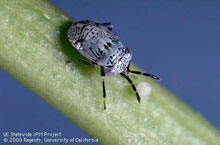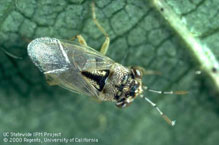home | fall garden | rose garden
Big-Eyed Bug
Big-eyed bugs get their name from their distinctive, wide-set, bulging eyes. There are 5 different species throughout the United States. All are general predators feeding on insects that many consider as pests. Big-eyed bugs are present in fields, gardens, and lawns. A female big-eyed bug can produce eggs for most of her life and will average laying 1 to 2 eggs per day. Eggs hatch in 5 to 10 days, depending on the average temperature. Once hatched, nymphs (immature stage) start feeding in clusters on a variety of insect eggs including those of mites, aphids, and leafhoppers. Nymphs look similar to their adult stage, except they do not have wings. It takes an average of 30 days for the nymphs to develop into an adult. Adults have oval bodies with broad heads and large, backward projecting eyes. They are also distinguishable by their short antennae with an enlarged tip. Adults are usually gray, brown or yellow in color. They are a blessing to many gardeners because they live longer than most insects, 3 to 4 months. During this time, adult big-eyed bugs are able to stalk and kill other insects such as caterpillars, spider mites, and flea beetles.
 |
 |
 |
